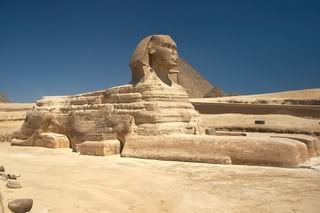
Buried for most of its life in the desert sand, an air of mystery has always surrounded the Great Sphinx, causing speculation about its age and purpose, method of construction, concealed chambers, role in prophesy, and relationship to the equally mysterious pyramids.
Much of this theorizing is to the despair of Egyptologists and archaeologists, who, reasonably it seems to me; only give credence to theories that are backed up by tangible evidence.
The Mystery of the Great Sphinx
Facing the rising sun, the Great Sphinx is located on the Giza plateau, about 10km west of Cairo, on the west bank of the Nile River. Later Egyptian rulers worshipped it as an aspect of the sun god, calling it Hor-Em-Akhet (“Horus of the Horizon”). The Sphinx sits in part of the necropolis of ancient Memphis, the seat of power for the pharaohs, a short distance from three large pyramids – the Great Pyramid of Khufu (Cheops), Khafre (Chephren) and Menkaura (Mycerinus).
The monument is the largest surviving sculpture from the ancient world, measuring 73.5m in length and in parts 20m in height. Part of the uraeus (sacred cobra which protected from evil forces), the nose and the ritual beard are missing; the beard is now displayed in the British Museum. The extensions at the side of the head are part of the royal headcloth. Although the head of the Sphinx has been badly affected by thousands of years of erosion, traces of the original paint can still be seen near one ear.
It is thought that originally the Sphinx’s face was painted dark red. A small temple between its paws contained dozens of inscribed stelae placed by the Pharaohs in honour of the Sun god.
The Pharaoh’s Dream
The Sphinx has suffered greatly from the ravages of time, man and modern pollution. In fact, what has saved it from complete destruction is the fact that it has been submerged beneath the desert sand for most of its life. There have been various attempts to restore the Great Sphinx over the millennia, beginning in c1400 BC with the pharaoh Tuthmosis IV. After falling asleep in the shade of the Sphinx when out hunting, the pharaoh dreamt that the great beast was choking from the sand engulfing it, and that it told him if he cleared the sand he would obtain the crown of Upper and Lower Egypt. In between the front paws of the Sphinx is a granite stela, now called the “Dream Stela”, which is inscribed with the story of the pharaoh’s dream.
Towards the end of 2010, during routine excavation work in the area of the monument, Egyptian archaeologists discovered large sections of mudbrick walls which were part of a larger wall which stretched for 132 meters (433 feet) around the Great Sphinx. The archaeologists believe that the wall was built by Tuthmosis IV after his dream to protect the Sphinx from the desert winds.
After the clearing ordered by Tuthmosis IV, and despite the wall, the colossal sculpture once again found itself beneath the sand. When Napoleon arrived in Egypt in 1798, he found the Sphinx without its nose. 18th century drawings reveal that the nose was missing long before Napoleon’s arrival; one story goes that it was the victim of target practice in the Turkish period. Another and perhaps the most likely explanation, is that it was pried off by chisels in the 8th century AD, by a Sufi who considered the Sphinx a sacrilegious idol. In 1858, some of the sand around the sculpture was cleared by Auguste Mariette, the founder of the Egyptian Antiquities Service, and between 1925 and 1936, French engineer Emile Baraize excavated the Sphinx on behalf of the Antiquities Service. Possibly for the first time since antiquity, the Great Sphinx was once again exposed to the elements.
Who does the Great Sphinx Depict?
The explanation for the enigmatic sculpture favoured by most Egyptologists is that Chephren, a Fourth Dynasty pharaoh, had the stone shaped into a lion with his own face at the same time as the construction of the nearby Pyramid of Chephren, around 2540 BC. However, there are no inscriptions anywhere that identify Chephren with the Sphinx, neither is there mention anywhere of its construction, which is somewhat puzzling when considering the grandness of the monument. Despite many Egyptologists claims to the contrary no-one knows for sure when the Sphinx was built or by whom.
In 1996, a New York detective and expert in identification concluded that the visage of the Great sphinx did not match known representations of Chephren’s face. He maintained that there was a greater resemblance to Chephren’s elder brother Djedefre. The debate is still continuing. The mystery of the Sphinx’s origin and purpose has often given rise to mystical interpretations, such as those of English occultist Paul Brunton and, in the 1940′s, controversial American psychic and prophet Edgar Cayce.
http://brian-haughton.com/
Read More Other Unsolved Mysteries article!



